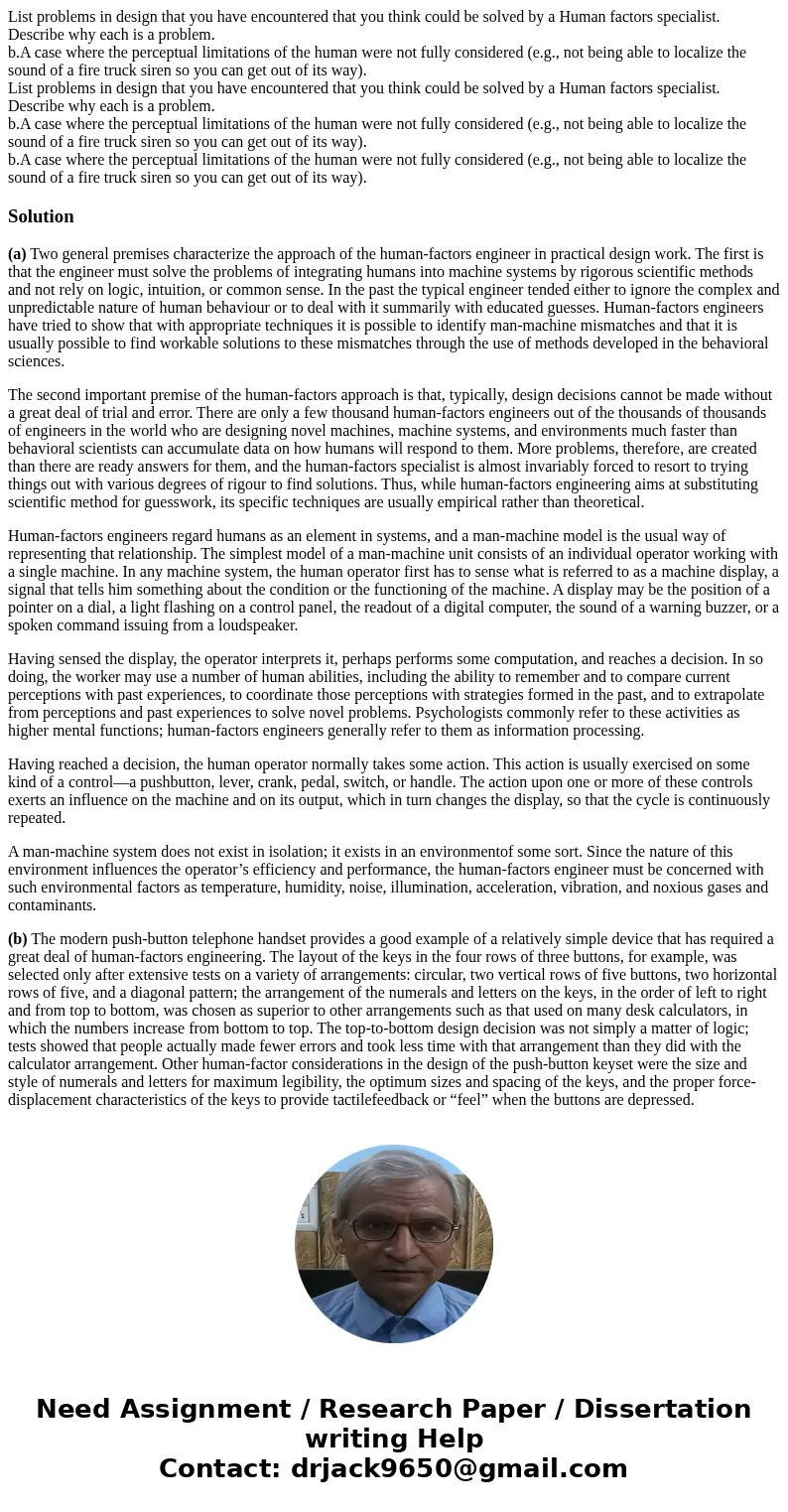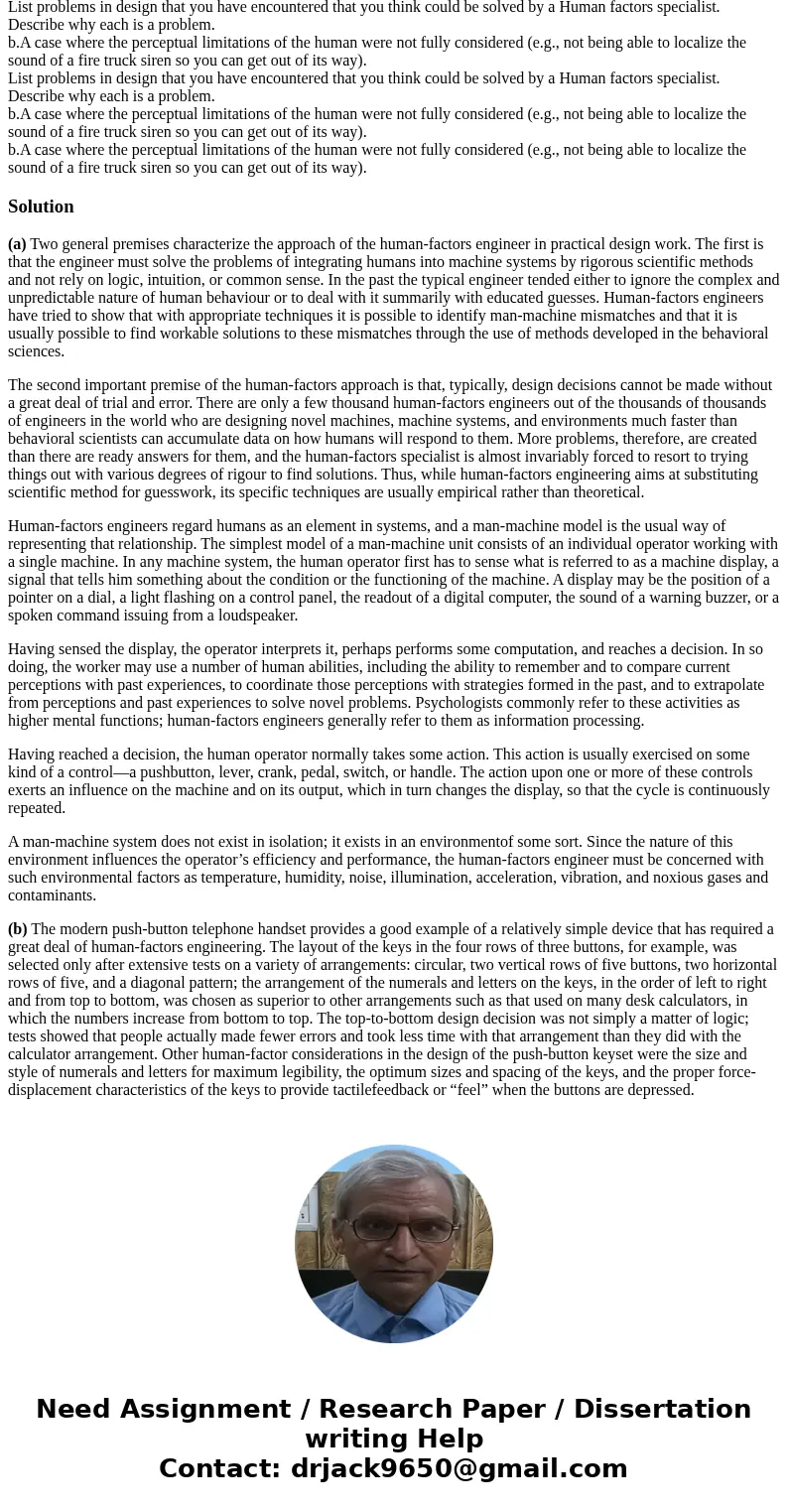List problems in design that you have encountered that you t
Solution
(a) Two general premises characterize the approach of the human-factors engineer in practical design work. The first is that the engineer must solve the problems of integrating humans into machine systems by rigorous scientific methods and not rely on logic, intuition, or common sense. In the past the typical engineer tended either to ignore the complex and unpredictable nature of human behaviour or to deal with it summarily with educated guesses. Human-factors engineers have tried to show that with appropriate techniques it is possible to identify man-machine mismatches and that it is usually possible to find workable solutions to these mismatches through the use of methods developed in the behavioral sciences.
The second important premise of the human-factors approach is that, typically, design decisions cannot be made without a great deal of trial and error. There are only a few thousand human-factors engineers out of the thousands of thousands of engineers in the world who are designing novel machines, machine systems, and environments much faster than behavioral scientists can accumulate data on how humans will respond to them. More problems, therefore, are created than there are ready answers for them, and the human-factors specialist is almost invariably forced to resort to trying things out with various degrees of rigour to find solutions. Thus, while human-factors engineering aims at substituting scientific method for guesswork, its specific techniques are usually empirical rather than theoretical.
Human-factors engineers regard humans as an element in systems, and a man-machine model is the usual way of representing that relationship. The simplest model of a man-machine unit consists of an individual operator working with a single machine. In any machine system, the human operator first has to sense what is referred to as a machine display, a signal that tells him something about the condition or the functioning of the machine. A display may be the position of a pointer on a dial, a light flashing on a control panel, the readout of a digital computer, the sound of a warning buzzer, or a spoken command issuing from a loudspeaker.
Having sensed the display, the operator interprets it, perhaps performs some computation, and reaches a decision. In so doing, the worker may use a number of human abilities, including the ability to remember and to compare current perceptions with past experiences, to coordinate those perceptions with strategies formed in the past, and to extrapolate from perceptions and past experiences to solve novel problems. Psychologists commonly refer to these activities as higher mental functions; human-factors engineers generally refer to them as information processing.
Having reached a decision, the human operator normally takes some action. This action is usually exercised on some kind of a control—a pushbutton, lever, crank, pedal, switch, or handle. The action upon one or more of these controls exerts an influence on the machine and on its output, which in turn changes the display, so that the cycle is continuously repeated.
A man-machine system does not exist in isolation; it exists in an environmentof some sort. Since the nature of this environment influences the operator’s efficiency and performance, the human-factors engineer must be concerned with such environmental factors as temperature, humidity, noise, illumination, acceleration, vibration, and noxious gases and contaminants.
(b) The modern push-button telephone handset provides a good example of a relatively simple device that has required a great deal of human-factors engineering. The layout of the keys in the four rows of three buttons, for example, was selected only after extensive tests on a variety of arrangements: circular, two vertical rows of five buttons, two horizontal rows of five, and a diagonal pattern; the arrangement of the numerals and letters on the keys, in the order of left to right and from top to bottom, was chosen as superior to other arrangements such as that used on many desk calculators, in which the numbers increase from bottom to top. The top-to-bottom design decision was not simply a matter of logic; tests showed that people actually made fewer errors and took less time with that arrangement than they did with the calculator arrangement. Other human-factor considerations in the design of the push-button keyset were the size and style of numerals and letters for maximum legibility, the optimum sizes and spacing of the keys, and the proper force-displacement characteristics of the keys to provide tactilefeedback or “feel” when the buttons are depressed.


 Homework Sourse
Homework Sourse